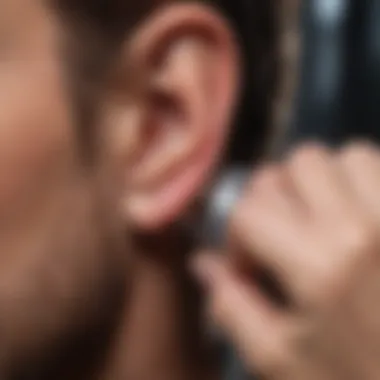Effective Strategies for Removing Water from the Ear


Intro
Water trapped in the ear can create discomfort and possible health issues. This problem often arises after swimming, showering, or activities involving water. In most cases, individuals experience a feeling of fullness or pressure in the ear. It is essential to address this situation effectively to prevent complications such as infections.
Understanding various strategies to remove water from the ear is vital. The following sections will explore safe home techniques and when professional intervention may be necessary.
Effective Techniques for Removing Water from the Ear
Simple Home Methods
There are several methods that can be safely utilized at home:
- Gravity Method: Tilt your head to one side, allowing gravity to assist in draining the trapped water.
- Jaw Movements: Moving your jaw by yawning or chewing can create pressure changes that help dislodge the water.
- Evaporation with Heat: Using a hair dryer on a low setting, hold it about a foot away from the ear to encourage evaporation. This should be done cautiously to avoid burns.
Always keep the dryer at a safe distance to prevent any discomfort.
When to Seek Professional Help
If home methods do not provide relief, seeking medical attention may be necessary. Professional interventions may include:
- Ear Irrigation: A healthcare provider may flush out the ear canal using a special solution.
- Suction: In cases of severe blockage, a doctor might utilize suction techniques to clear the ear.
Importance of Ear Health
Promptly addressing trapped water is important. Avoiding prolonged moisture in the ear can help prevent infections like swimmer's ear. Regular checks on ear health are advisable, especially for individuals with recurring issues.
Ending
Water trapped in the ear is a common issue that can often be resolved using simple techniques. However, taking the problem seriously is key to avoiding complications. Monitoring your ear health and knowing when to seek professional help can ensure a better outcome.
Understanding the Issue
Understanding the issue of water trapped in the ear is crucial, especially for individuals involved in activities where immersion in water is frequent. This predicament can often lead to discomfort, temporary hearing loss, and even infections if not addressed properly. Recognizing how to manage this issue is vital for maintaining ear health, which is often overlooked.
Nature of Ear Anatomy
The ear comprises three main sections: the outer ear, middle ear, and inner ear. The outer ear collects sound waves and channels them through the ear canal to the eardrum located in the middle ear. The middle ear contains tiny bones that vibrate in response to sound. Understanding this anatomy is essential, as the ear canal is a narrow space where water can easily become trapped.
The ear canal is lined with skin that is sensitive and can react negatively to water, especially if it remains trapped for extended periods. The design of the ear canal curves, which can contribute to water retention. Therefore, knowing this anatomy is beneficial when discussing strategies for effective water removal.
Causes of Water Getting Trapped
Water can get trapped in the ear for several reasons. Common causes include:
- Swimming: Immersion in pools, lakes, and oceans can lead to water entering the ear canal.
- Showering: Water can splash into the ears during showers, leading to retention.
- Water Sports: Activities like surfing, diving, and wakeboarding can introduce water into the ear.
- Ear Wax: Sometimes, excessive ear wax can trap water, preventing drainage.
These situations are typical among athletes and thrill-seekers who frequently engage in water-related activities. Understanding these causes allows individuals to anticipate and manage potential water retention effectively.
Symptoms of Water in the Ear
Recognizing the symptoms of water trapped in the ear can aid in quick intervention. Common symptoms include:
- A feeling of fullness in the ear.
- Discomfort or pain that may vary in intensity.
- Hearing difficulties, such as muffled sounds or reduced auditory sensitivity.
- A tinkling or crackling sound during jaw movement.
Addressing these symptoms quickly can make the difference between a simple situation and a more severe issue, such as infections. Immediate recognition and action can lead to effective solutions and maintain overall ear health.
Immediate Actions to Take
Immediate actions are crucial when it comes to removing water trapped in the ear. The steps taken right after realizing that water is present can often determine the comfort level and potential complications. Knowing how to respond effectively can minimize risks such as infections or long-term damage. Timely intervention can also alleviate discomfort, leading to a more pleasant experience, especially for those who engage in water-related activities.


Assessing the Situation
Determining Severity
Determining the severity of the situation when water is trapped in the ear is vital. It helps to identify if immediate action is needed or if a simple home remedy would suffice. The key characteristic of determining severity lies in gauging discomfort and potential risk factors. A beneficial choice, this step can aid individuals in saving time and unnecessary worry.
By understanding how much discomfort is being experienced and whether there are symptoms of infection, this evaluation can lead to individualized approaches for remedy. For instance, if the water has been trapped for a long period, this could indicate a more complex issue that requires professional attention.
Notably, a unique feature is that severity is not solely based on physical signs but also on personal experience. This aspect can influence information accuracy and decision-making during the process.
Recognizing Discomfort
Recognizing discomfort can significantly contribute to understanding the situation at hand. It serves as an immediate indicator of potential issues arising from trapped water. The main characteristic here is the ability to assess internal sensations and correlate them with possible underlyings causes.
This recognition becomes a pivotal part of self-awareness regarding one's ear health. It is beneficial as it guides individuals toward choosing appropriate corrective actions. Furthermore, it supports informed communication with medical professionals if needed.
One unique feature of this recognition is how subjective it can be. Different people might have varying levels of sensitivity to similar circumstances. This can sometimes lead to underestimating a situation when in fact, discomfort may be a signal of more significant issues.
First Aid Techniques
Tilting the Head
Tilting the head can be an effective first aid technique when attempting to remove water from the ear. It works by using gravity to encourage the water to exit the ear canal. The key characteristic of this method is its simplicity and the lack of need for any tools or additional aids. This makes it accessible to virtually anyone, regardless of location.
What makes this method a popular choice is its intuitive nature. Most people can quickly understand how to implement this technique, as it doesn't require special training or equipment. However, a disadvantage may arise for those who cannot tilt their neck effectively due to injury or other physical limitations.
Gravity-Based Techniques
Gravity-based techniques refer to the various methods that utilize the force of gravity to aid in the removal of water. This is a fundamental approach that is commonly practiced. Its main characteristic centers around simply allowing the trapped water to flow out without additional pressure.
A significant aspect of this method is its non-invasive quality. It may be preferred by many individuals because it poses minimal risks and complexities. While applying this technique is straightforward, there are challenges regarding its effectiveness in specific positions or if the water is stubbornly stuck.
Effective use of gravity-based strategies can significantly reduce discomfort and promote a quicker resolution to the issue at hand. Therefore, these techniques are significant in the overall approach to water removal from the ear.
Home Remedies
Home remedies play a crucial role in managing the discomfort caused by water trapped in the ear. They offer safe, accessible, and often effective solutions without the immediate need for medical intervention. Utilizing methods that can be easily implemented at home allows individuals to maintain their ear health while preventing potential complications arising from prolonged moisture. This section explores various home remedies, detailing their benefits and precautions.
Use of Heat
Heat applications can promote the drainage of trapped water by enhancing circulation in the ear area and softening any earwax that may be present. Using heat is a gentle and non-invasive method that many find effective. It's important to approach this method with care to avoid burns or excessive heat exposure.
Warm Compress Method
The warm compress method involves applying a warm cloth or towel to the outer ear. This technique is beneficial as it provides immediate warmth, which can alleviate discomfort and aid in the movement of trapped water toward the ear canal.
One key characteristic of the warm compress is its simplicity. It requires minimal materials and is easily adaptable to different preferences. Using this method has the advantage of being safe for most individuals, including children.
However, the unique feature of the warm compress is that it must be warm, not hot, to prevent burns. An incorrect temperature could lead to more harm than good. Despite this, when applied correctly, the warm compress is a popular choice for easing ear discomfort.
Heating Pads
Heating pads are another effective way to apply heat to the ear area. They can provide consistent warmth over a period of time, which may help in loosening any blockage that could be trapping water.
The key characteristic of heating pads is their adjustable temperature settings, allowing users to find the right level for comfort. This contributes positively to the overall goal of alleviating discomfort due to water in the ear. Many people prefer heating pads for their ability to deliver sustained heat without constant readjustment.
However, one should be cautious of prolonged exposure, as excessive heat can lead to skin irritation or burns. As with the warm compress, careful usage is essential to reap the benefits of heating pads while avoiding their disadvantages.
Vaporization Techniques
Vaporization techniques involve the use of steam to promote moisture evaporation and facilitate drainage from the ear. These methods not only address the issue of trapped water but can also soothe associated discomfort.


Steam Inhalation
Steam inhalation is an effective method for combating trapped water in the ear. By inhaling steam, you can clear your sinus passages, which may indirectly ease ear pressure. The warmth of the steam helps in loosening any buildup.
The benefit of steam inhalation is that it’s generally safe and can be done at home without special equipment. This method encourages relaxation, contributing positively to overall ear health by relieving discomfort caused by pressure.
However, one must take care not to get too close to the hot steam to prevent burns. A unique aspect of steam inhalation is the additional improvement in respiratory comfort, making it a dual-purpose remedy; this is its primary advantage.
Hot Shower Techniques
Taking a hot shower can help in a similar way to steam inhalation. The steam produced in the shower can aid in loosening mucus and help to relieve pressure in the ears. This method is particularly effective for those who may not have access to other steam-producing methods.
The key characteristic of the hot shower technique is its accessibility—almost anyone can benefit from this while performing a daily activity. It has the added advantage of being a more pleasant experience for many, making it an appealing option for those dealing with ear discomfort.
However, caution should be exercised in terms of water temperature and duration. A unique feature of using a hot shower is that it can be seamlessly integrated into daily routines, which presents a convenience not found in more rigid methods.
Hydration and Movement
Staying hydrated and engaging in specific movements can also be effective strategies for hastening the removal of water from the ear. These methods support physiological processes that assist in drainage and maintenance of ear health.
Drinking Water
Drinking water can facilitate the drainage of trapped water in the ear. Hydration ensures that all bodily functions, including those involved in ear drainage, operate effectively. Keeping the body well-hydrated can help the eustachian tubes function more efficiently and promote overall ear health.
A key characteristic of this method is that it is simple and requires only access to fresh water. This makes drinking water a beneficial choice for anyone dealing with ear issues.
However, the challenge is that drinking water alone may not resolve the issue immediately, as it often needs a combination with other methods to see effective results. The unique feature is the importance of overall hydration, which supports broader health beyond just addressing ear problems.
Jaw Movements
Jaw movements can help in equalizing pressure in the ears and encouraging the movement of trapped water. Simple actions such as yawning, chewing, or moving the jaw can enhance eustachian tube function.
The benefit of this approach is it is a physical method that requires no additional resources. It can be done anywhere and anytime, thus it is a practical remedy for individuals on the go.
However, its effectiveness may vary between individuals, and not everyone may find it helpful. The unique aspect of jaw movements is their non-invasive nature, making them a convenient option to include in daily life without needing any special setup.
Alternative Methods
Alternative methods for removing water from the ear are practical for those who prefer an approach that is distinct from home remedies or professional help. These techniques can serve as effective supplementary options. It is important to consider these alternatives, especially when traditional methods do not yield satisfactory results. Understanding how these methods work can empower individuals to take control of their ear health.
Using Alcohol and Vinegar
Preparation of Solutions
The preparation of solutions using alcohol and vinegar is a crucial step in the process. This mixture is well-known for its ability to help displace water trapped in the ear. The key characteristic of this solution is its dual action; alcohol evaporates quickly while vinegar can help neutralize any bacteria. This makes it a beneficial choice for addressing not only water retention but also potential infections.
To prepare this solution, one part of white vinegar should be mixed with one part of rubbing alcohol. This combination is popular due to its effectiveness at drying out excess moisture. However, individuals should be cautious, as too much alcohol can irritate the sensitive ear canal, leading to discomfort.
Application Techniques
Application techniques for using the alcohol and vinegar solution involve a measured and careful approach. The typical method is to apply a few drops into the affected ear using a dropper. Doing so allows the solution to work its way into the ear canal, helping to displace water. This technique is favored because it is simple and can be done at home with minimal preparation.
One unique feature of this application is the ability to enhance gravity's role in the process. After instilling the solution, tilting the head can encourage drainage. The advantage here lies in its effectiveness, but individuals must take care not to overuse it, as repeated applications may lead to irritation or dryness in the ear.
Over-the-Counter Remedies
Types of Ear Drops
Types of ear drops available in pharmacies are specifically formulated to help with ear moisture issues. These drops often have ingredients designed to facilitate the drying out of excess water. The advantage of using commercial ear drops is that they usually come with instructions for use and are designed for safety and efficacy.
Some common active ingredients include isopropyl alcohol and glycerin, which help in drying and soothing the ear canal. However, when selecting ear drops, it is essential to check that they are suitable for the individual’s needs. Some formulations may not work effectively for all individuals.


Consultation on Usage
Consultation on the usage of over-the-counter remedies is key to ensuring safety and effectiveness. Many consumers overlook this aspect, opting to use remedies without professional guidance. Consulting with a pharmacist or physician can provide critical insights into which products may work best.
A unique feature of this consultation is that it can prevent unnecessary misuse of the product. For instance, some individuals might not realize that certain drops are contraindicated if they have a perforated eardrum. Therefore, seeking advice can mitigate risks and enhance the outcome of treatment.
Always prioritize safety when dealing with ear health. Consultation with a healthcare provider can lead to better choices.
By exploring these alternative methods, individuals can maintain their ear health effectively. Whether through simple at-home solutions like alcohol and vinegar or selecting suitable over-the-counter remedies, awareness of one's choices contributes to a proactive approach to ear care. This understanding fosters confidence and encourages individuals to address issues promptly.
Professional Interventions
Professional interventions are crucial when home remedies and techniques do not yield the desired results for removing water from the ear. The risk of complications, such as ear infections or prolonged discomfort, increases if water remains trapped for an extended period. Seeking medical help offers an opportunity for safe and effective solutions that can prevent further issues. The timely intervention by healthcare professionals can make a significant difference in the management of ear health.
When to Seek Medical Help
Recognizing the need for medical assistance is the first step towards resolving the issue of water trapped in the ear. Consult a healthcare professional if:
- Water loss does not occur within a few days.
- You experience severe pain or discomfort.
- There is a noticeable reduction in hearing.
- Symptoms like dizziness or ear drainage develop.
It's essential to take these signals seriously as ignoring them can lead to more severe health concerns.
Possible Medical Procedures
When professionals are involved, they have various methods to help eliminate water effectively. Below are two common procedures:
Manual Removal Techniques
Manual removal techniques are direct methods that healthcare professionals use to help extract water from the ear. This approach is often recommended because it is immediate and usually effective.
- Key Characteristic: Manual removal typically involves physical techniques, where the healthcare provider may manipulate the ear or use instruments to draw out the fluid.
- Benefits: This method provides a quick solution, reducing the risk of prolonged discomfort and further complications.
- Unique Feature: It allows for direct intervention, which can be tailored to the specific needs of the patient.
- Advantages: As it is performed by a professional, the risk of injury to the ear canal is minimized.
- Disadvantages: There is a level of discomfort during the process, and not every case may be suitable for this technique.
Use of Suction
Suction is another professional method used to remove water from the ear effectively. This technique is advantageous for more stubborn cases where water does not exit easily.
- Key Characteristic: Using a suction device, the healthcare provider creates a vacuum to draw out trapped fluid from the ear canal safely.
- Benefits: It is efficient and minimizes the risk of damaging the sensitive ear structures.
- Unique Feature: This non-invasive procedure can be done in a clinical setting and is often a preferred method for persistent cases.
- Advantages: Suction is quick and can provide immediate relief, allowing patients to leave the clinic with their hearing restored.
- Disadvantages: Occasionally, this method may not be suitable for patients with specific ear conditions or physical issues.
Preventive Measures
Taking preventive measures is crucial for anyone looking to maintain ear health and avoid the discomfort of water trapped in the ear. Understanding these strategies is essential, especially for those who partake in activities that expose them to water, such as swimming, surfing, or other water sports. Preventing water from becoming trapped can save individuals from the need for more invasive interventions later.
Proper Ear Cleansing Techniques
Proper ear cleansing plays a significant role in preventing water accumulation. Sensitive ear areas should be cleaned with care. Using cotton swabs can push wax deeper, which may block water passage. Instead, using a damp cloth to clean the outer ear is advisable. Natural earwax is protective and should not be removed excessively. Individuals should consult medical advice before employing any intensive cleaning solutions, ensuring their methods are safe and effective.
Swimming and Water Safety
Protective Ear Gear
Utilizing protective ear gear has a notable advantage in water activities. Earplugs designed for swimmers are particularly beneficial. They are designed to create a seal that keeps water out while allowing users to enjoy their aquatic pastimes. The key characteristic of these products is their snug fit, which prevents water from entering the ear canal. Some popular options include silicone earplugs, which offer comfort and a customizable fit. The unique feature of earplugs is their ability to reduce water pressure during dives or splashes. While they are highly effective, some wearers may find discomfort with prolonged use.
Pre-swim Precautions
Implementing pre-swim precautions is another effective way to minimize the risk of water getting trapped in the ear. This includes ensuring that individuals are thoroughly dried after showers or baths before entering the pool or sea. Overly wet hair can increase the chances of water entering the ears. Additionally, performing simple head movements to encourage water drainage before entering the water can be beneficial. This approach is particularly favored for its simplicity and effectiveness. However, it requires a consistent application to yield significant long-term benefits.
Closure
Addressing the issue of water trapped in the ear is crucial for maintaining overall ear health. The discomfort that accompanies this condition can hinder both day-to-day activities and specific pursuits such as swimming and other water sports. In this article, several strategies have been discussed, ranging from immediate actions to home remedies and professional interventions. By understanding these methods, one can effectively mitigate the discomfort caused by water retention in the ear.
Summary of Techniques
The techniques outlined in the article provide a comprehensive approach to dealing with trapped water. Immediate actions include simple maneuvers such as tilting the head or utilizing gravity-based techniques. Home remedies span from heat applications to hydration methods, demonstrating versatility in possible solutions. Alternative methods utilize common household substances like alcohol and vinegar, while over-the-counter solutions serve as convenient options for many.
Professional interventions are vital when home methods prove ineffective. Knowing when to seek medical help ensures that any potential complications are addressed promptly. Various medical procedures can facilitate relief and should be considered if the problem persists.
Final Thoughts on Ear Health
Taking care of your ear health should be part of a routine, particularly in activities that expose the ears to water. Awareness of symptoms and appropriate action can lead to a better experience in your favorite aquatic activities. As a thrill-seeker or an athlete, embedding these insights into your practice can make a notable difference.







